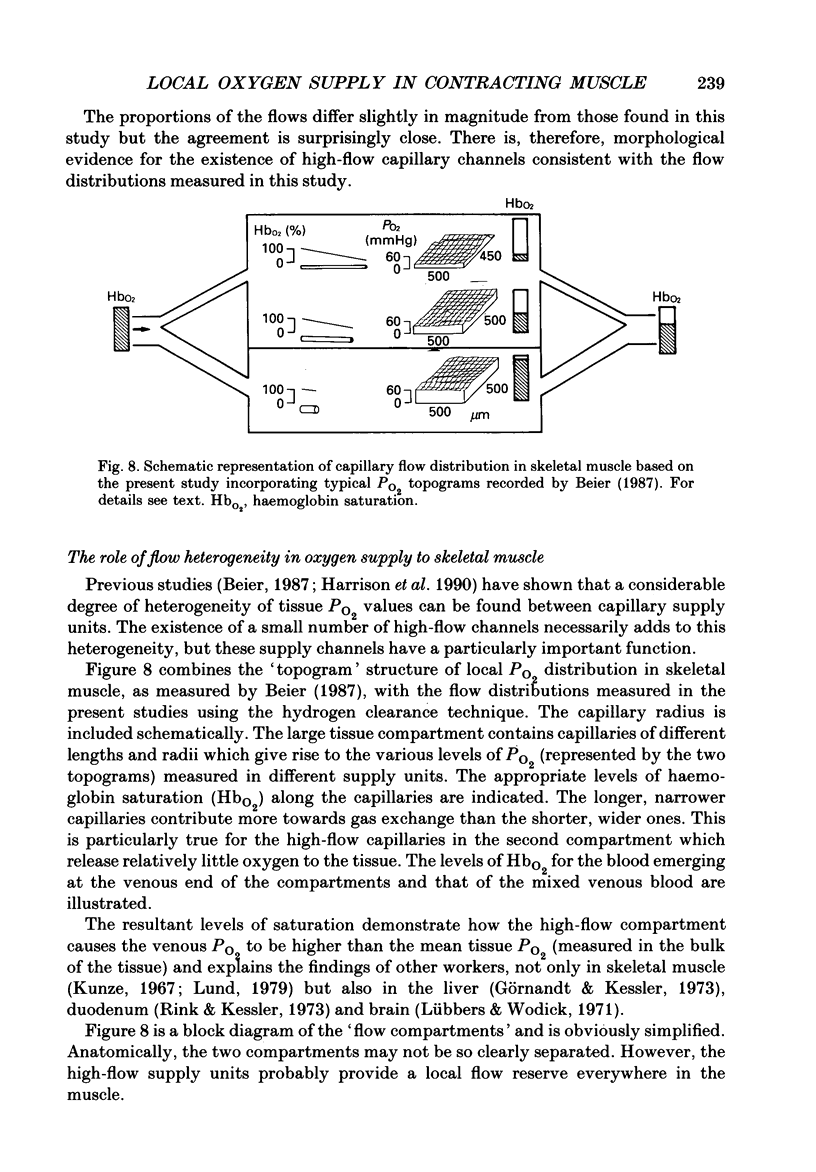Abstract
1. Multiwire surface electrodes were used to measure local hydrogen clearance curves and tissues PO2 in the sartorius muscle in dogs under resting conditions and during stimulation of the muscle at 1, 2, 4, 8 and 20 Hz via the femoral nerve. Tissue oxygen supply was assessed by means of PO2 histograms; evaluation of the initial slopes of the hydrogen clearance curves enabled the measurement of capillary blood flow. 2. In a further model, the analysis of hydrogen clearance curves measured in the femoral vein using intravascular needle electrodes in rabbits enabled the distribution of blood flow to be evaluated both under resting conditions and during direct 2 Hz stimulation of the vastus medialis muscle. 3. Increased oxygen consumption, induced by stimulation, caused increases in capillary flow which were not necessarily accompanied by augmentation of femoral artery flow. 4. PO2 histograms provided no evidence of cellular anoxia even at the maximum level of oxygen consumption. 5. A two-compartment distribution of flow was measured under resting conditions, whereas only one compartment could be resolved during 2 Hz stimulation of the vastus medialis muscle in the rabbit experiments. A clear redistribution of flow was observed in the absence of any increase in total flow. 6. A model for oxygen-dependent regulation of capillary blood flow involving high-flow and normal-flow compartments is proposed.
Full text
PDF
















Selected References
These references are in PubMed. This may not be the complete list of references from this article.
- Armstrong R. B., Laughlin M. H. Blood flows within and among rat muscles as a function of time during high speed treadmill exercise. J Physiol. 1983 Nov;344:189–208. doi: 10.1113/jphysiol.1983.sp014933. [DOI] [PMC free article] [PubMed] [Google Scholar]
- Chance B. Early reduction of cytochrome c in hypoxia. FEBS Lett. 1988 Jan 4;226(2):343–346. doi: 10.1016/0014-5793(88)81451-0. [DOI] [PubMed] [Google Scholar]
- Gayeski T. E., Connett R. J., Honig C. R. Minimum intracellular PO2 for maximum cytochrome turnover in red muscle in situ. Am J Physiol. 1987 May;252(5 Pt 2):H906–H915. doi: 10.1152/ajpheart.1987.252.5.H906. [DOI] [PubMed] [Google Scholar]
- Gayeski T. E., Honig C. R. Myoglobin saturation and calculated PO2 in single cells of resting gracilis muscles. Adv Exp Med Biol. 1977 Jul 4;94:77–84. doi: 10.1007/978-1-4684-8890-6_11. [DOI] [PubMed] [Google Scholar]
- Groebe K., Thews G. Theoretical analysis of oxygen supply to contracted skeletal muscle. Adv Exp Med Biol. 1986;200:495–514. doi: 10.1007/978-1-4684-5188-7_62. [DOI] [PubMed] [Google Scholar]
- Harrison D. K., Birkenhake S., Knauf S., Hagen N., Beier I., Kessler M. The role of high flow capillary channels in the local oxygen supply to skeletal muscle. Adv Exp Med Biol. 1988;222:623–630. doi: 10.1007/978-1-4615-9510-6_77. [DOI] [PubMed] [Google Scholar]
- Harrison D. K., Günther H., Vogel H., Ellermann R., Brunner M., Höper J., Kessler M. Oxygen supply and microcirculation of the beating dog heart after haemodilution with fluosol DA 20%. Adv Exp Med Biol. 1985;191:445–452. doi: 10.1007/978-1-4684-3291-6_45. [DOI] [PubMed] [Google Scholar]
- Harrison D. K., Kessler M. A multiwire hydrogen electrode for in vivo use. Phys Med Biol. 1989 Oct;34(10):1397–1412. doi: 10.1088/0031-9155/34/10/004. [DOI] [PubMed] [Google Scholar]
- Harrison D. K., Kessler M., Knauf S. K. Regulation of capillary blood flow and oxygen supply in skeletal muscle in dogs during hypoxaemia. J Physiol. 1990 Jan;420:431–446. doi: 10.1113/jphysiol.1990.sp017921. [DOI] [PMC free article] [PubMed] [Google Scholar]
- Harrison D. K., Kessler M. Local hydrogen clearance as a method for the measurement of capillary blood flow. Phys Med Biol. 1989 Oct;34(10):1413–1428. doi: 10.1088/0031-9155/34/10/005. [DOI] [PubMed] [Google Scholar]
- Kazmers A., Whitehouse W. M., Jr, Zelenock G. B., Cronenwett J. L., Lindenauer S. M., Stanley J. C. Early derangements of arteriovenous anastomotic and capillary blood flow in the canine hindlimb induced by supplemental pentobarbital anesthesia. J Surg Res. 1984 Feb;36(2):102–107. doi: 10.1016/0022-4804(84)90074-x. [DOI] [PubMed] [Google Scholar]
- Kessler M., Höper J., Harrison D. K., Skolasinska K., Klövekorn W. P., Sebening F., Volkholz H. J., Beier I., Kernbach C., Rettig V. Tissue O2 supply under normal and pathological conditions. Adv Exp Med Biol. 1984;169:69–80. doi: 10.1007/978-1-4684-1188-1_4. [DOI] [PubMed] [Google Scholar]
- Lund N. Skeletal and cardiac muscle oxygenation. Adv Exp Med Biol. 1985;191:37–43. doi: 10.1007/978-1-4684-3291-6_3. [DOI] [PubMed] [Google Scholar]
- Potter R. F., Groom A. C. Capillary diameter and geometry in cardiac and skeletal muscle studied by means of corrosion casts. Microvasc Res. 1983 Jan;25(1):68–84. doi: 10.1016/0026-2862(83)90044-4. [DOI] [PubMed] [Google Scholar]
- Rink R., Kessler M. Signs of hypoxia in the small intestine of the rat during hemorrhagic shock. Adv Exp Med Biol. 1973;37A:469–475. doi: 10.1007/978-1-4684-3288-6_59. [DOI] [PubMed] [Google Scholar]
- Starlinger H., Lübbers D. W. Polarographic measurements of the oxygen pressure performed simultaneously with optical measurements of the redox state of the respiratory chain in suspensions of mitochondria under steady-state conditions at low oxygen tensions. Pflugers Arch. 1973;341(1):15–22. doi: 10.1007/BF00587326. [DOI] [PubMed] [Google Scholar]
- Tamura M., Hazeki O., Nioka S., Chance B. In vivo study of tissue oxygen metabolism using optical and nuclear magnetic resonance spectroscopies. Annu Rev Physiol. 1989;51:813–834. doi: 10.1146/annurev.ph.51.030189.004121. [DOI] [PubMed] [Google Scholar]
- ZIERLER K. L. EQUATIONS FOR MEASURING BLOOD FLOW BY EXTERNAL MONITORING OF RADIOISOTOPES. Circ Res. 1965 Apr;16:309–321. doi: 10.1161/01.res.16.4.309. [DOI] [PubMed] [Google Scholar]


